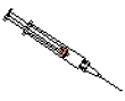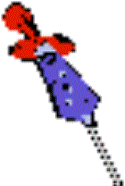Heroin

What is heroin?
Heroin is
an illegal, highly addictive drug. It is both the most abused and the
most rapidly acting of the opiates. Heroin is processed from morphine,
a naturally occurring substance extracted from the seed pod of certain
varieties of poppy plants. It is typically sold as a white or brownish
powder or as the black sticky substance known on the streets as "black
tar heroin." Although purer heroin is becoming more common, most
street heroin is "cut" with other drugs or with substances such as
sugar, starch, powdered milk, or quinine. Street heroin can also be
cut with strychnine or other poisons. Because heroin abusers do not
know the actual strength of the drug or its true contents, they are at
risk of overdose or death. Heroin also poses special problems because
of the transmission of HIV and other diseases that can occur from
sharing needles or other injection equipment.

How is heroin used?
Heroin is usually injected, sniffed/snorted,
or smoked. Typically, a heroin abuser may inject up to four times a
day. Intravenous injection provides the greatest intensity and most
rapid onset of euphoria (7 to 8 seconds), while intramuscular
injection produces a relatively slow onset of euphoria (5 to 8 minutes).
When heroin is sniffed or smoked, peak effects are usually felt within
10 to 15 minutes. Although smoking and sniffing heroin do not produce
a "rush" as quickly or as intensely as intravenous injection, NIDA
researchers have confirmed that all three forms of heroin
administration are addictive.
Injection continues to be the
predominant method of heroin use among addicted users seeking
treatment; however, researchers have observed a shift in heroin use
patterns, from injection to sniffing and smoking. In fact,
sniffing/snorting heroin is now a widely reported means of taking
heroin among users admitted for drug treatment in Newark, Chicago, New
York, and Detroit.
With the shift in heroin abuse patterns
comes an even more diverse group of users. Older users (over 30)
continue to be one of the largest user groups in most national data.
However, several sources indicate an increase in new, young users
across the country who are being lured by inexpensive, high-purity
heroin that can be sniffed or smoked instead of injected. Heroin has
also been appearing in more affluent communities.
What are the long-term effects of heroin use?

One of the most detrimental long-term effects of heroin is
addiction itself. Addiction is a chronic, relapsing disease,
characterized by compulsive drug seeking and use, and by neurochemical
and molecular changes in the brain. Heroin also produces profound
degrees of tolerance and physical dependence, which are also powerful
motivating factors for compulsive use and abuse. As with abusers of
any addictive drug, heroin abusers gradually spend more and more time
and energy obtaining and using the drug. Once they are addicted, the
heroin abusers' primary purpose in life becomes seeking and using
drugs. The drugs literally change their brains.
Physical
dependence develops with higher doses of the drug. With physical
dependence, the body adapts to the presence of the drug and withdrawal
symptoms occur if use is reduced abruptly. Withdrawal may occur within
a few hours after the last time the drug is taken. Symptoms of
withdrawal include restlessness, muscle and bone pain, insomnia,
diarrhea, vomiting, cold flashes with goose bumps ("cold turkey"), and
leg movements. Major withdrawal symptoms peak between 24 and 48 hours
after the last dose of heroin and subside after about a week. However,
some people have shown persistent withdrawal signs for many months.
Heroin withdrawal is never fatal to otherwise healthy adults, but it
can cause death to the fetus of a pregnant addict.

At some point during continuous heroin use, a person can become
addicted to the drug. Sometimes, addicted individuals will endure many
of the withdrawal symptoms to reduce their tolerance for the drug so
that they can again experience the rush.
Physical dependence
and the emergence of withdrawal symptoms were once believed to be the
key features of heroin addiction. We now know this may not be the case
entirely, since craving and relapse can occur weeks and months after
withdrawal symptoms are long gone. We also know that patients with
chronic pain who need opiates to function (sometimes over extended
periods) have few if any problems leaving opiates after their pain is
resolved by other means. This may be because the patient in pain is
simply seeking relief of pain and not the rush sought by the addict.

Short- and Long-Term Effects of Heroin Use
Short-Term
Effects
"Rush"
Depressed respiration
Clouded mental
functioning
Nausea and vomiting
Suppression of pain
Spontaneous abortion

Long-Term Effects
Addiction
Infectious diseases, for
example, HIV/AIDS and hepatitis B and C
Collapsed veins
Bacterial infections
Abscesses
Infection of heart lining and
values
Arthritis and other rheumatologic problems

What are the medical complications of chronic heroin use?
Medical consequences of chronic heroin abuse include scarred and/or
collapsed veins, bacterial infections of the blood vessels and heart
valves, abscesses (boils) and other soft-tissue infections, and liver
or kidney disease. Lung complications (including various types of
pneumonia and tuberculosis) may result from the poor health condition
of the abuser as well as from heroin's depressing effects on
respiration. Many of the additives in street heroin may include
substances that do not readily dissolve and result in clogging the
blood vessels that lead to the lungs, liver, kidneys, or brain. This
can cause infection or even death of small patches of cells in vital
organs. Immune reactions to these or other contaminants can cause
arthritis or other rheumatologic problems.
Of course, sharing
of injection equipment or fluids can lead to some of the most severe
consequences of heroin abuse - infections with hepatitis B and C,
HIV, and a host of other blood-borne viruses, which drug abusers can
then pass on to their sexual partners and children.

What are the treatments for heroin addiction?
A variety of
effective treatments are available for heroin addiction. Treatment
tends to be more effective when heroin abuse is identified early. The
treatments that follow vary depending on the individual, but
methadone, a synthetic opiate that blocks the effects of heroin and
eliminates withdrawal symptoms, has a proven record of success for
people addicted to heroin. Other pharmaceutical approaches, like LAAM
(levo-alpha-acetyl-methadol), and many behavioral therapies also are
used for treating heroin addiction.
Detoxification
The
primary objective of detoxification is to relieve withdrawal symptoms
while patients adjust to a drug-free state. Not in itself a treatment
for addiction, detoxification is a useful step only when it leads into
long-term treatment that is either drug-free (residential or
outpatient) or uses medications as part of the treatment. The best
documented drug-free treatments are the therapeutic community
residential programs lasting at least 3 to 6 months.

Treatments for Heroin Addiction
Methadone programs
Methadone treatment has been used effectively and safely to treat
opioid addiction for more than 30 years. The programs use methadone as
a substitute for heroin. Properly prescribed methadone is not
intoxicating or sedating, and its effects do not interfere with
ordinary activities such as driving a car. The medication is taken
orally and it suppresses narcotic withdrawal for 24 to 36 hours.
Patients are able to perceive pain and have emotional reactions. Most
important, methadone relieves the craving associated with heroin
addiction; craving is a major reason for relapse. Among methadone
patients, it has been found that normal street doses of heroin are
ineffective at producing euphoria, thus making the use of heroin more
easily extinguishable.
Methadone's effects last for about 24
hours - four to six times as long as those of heroin - so people in
treatment need to take it only once a day. Also, methadone is
medically safe even when used continuously for 10 years or more.
Combined with behavioral therapies or counseling and other supportive
services, methadone enables patients to stop using heroin (and other
opiates) and return to more stable and productive lives.
LAAM
and other medications
LAAM, like methadone, is a synthetic
opiate that can be used to treat heroin addiction. LAAM can block the
effects of heroin for up to 72 hours with minimal side effects when
taken orally. In 1993 the Food and Drug Administration approved the
use of LAAM for treating patients addicted to heroin. Its long
duration of action permits dosing just three times per week, thereby
eliminating the need for daily dosing and take-home doses for
weekends. LAAM will be increasingly available in clinics that already
dispense methadone.

Naloxone and naltrexone are medications that also block the effects of
morphine, heroin, and other opiates. As antagonists, they are
especially useful as antidotes. Naltrexone has long-lasting effects,
ranging from 1 to 3 days, depending on the dose. Naltrexone blocks the
pleasurable effects of heroin and is useful in treating some highly
motivated individuals. Naltrexone has also been found to be successful
in preventing relapse by former opiate addicts released from prison on
probation.
Although not yet approved for the treatment of
opioid addiction, buprenorphine is another medication being studied by
NIDA as a treatment for heroin addiction. Buprenorphine is a
particularly attractive treatment because it does not produce the same
level of physical dependence as other opiate medications, such as
methadone. Discontinuing buprenorphine is easier than stopping
methadone treatment because there are fewer withdrawal symptoms.
Several other medications with potential for treating heroin overdose
or addiction are currently under investigation by NIDA.

Behavioral therapies
Although behavioral and pharmacologic
treatments can be extremely useful when employed alone, science has
taught us that integrating both types of treatments will ultimately be
the most effective approach. There are many effective behavioral
treatments available for heroin addiction. These can include
residential and outpatient approaches. An important task is to match
the best treatment approach to meet the particular needs of the
patient. Moreover, several new behavioral therapies, such as
contingency management therapy and cognitive-behavioral interventions,
show particular promise as treatments for heroin addiction.
Contingency management therapy uses a voucher-based system, where
patients earn "points" based on negative drug tests, which they can
exchange for items that encourage healthy living. Cognitive-behavioral
interventions are designed to help modify the patient's thinking,
expectancies, and behaviors and to increase skills in coping with
various life stressors. Both behavioral and pharmacological treatments
help to restore a degree of normalcy to brain function and behavior.

| DARE | Alcohol |
| Cocaine |
Inhalants |
| LSD |
Methamphetamine |
|
PCP |
Marijuana |
|
Heroin |
| Home |
| Michele |
Links |
Sign Language |
| Adoptions |
Animals
| Say No To Drugs |
| Holidays | History |
|
All graphics and
pages are copyright © 1997 - 2008 Pages 4 Ever
(except where noted). Do not take, copy, steal, plagiarize or use in any
way, shape or format without the express written permission of Pages
4 Ever.
Some backgrounds and graphics made from clipart acquired from ArtToday, Boxed Art,
friends, my own imagination, and/or
graphic CD collections that I have purchased. If you find anything on this site
that you have copyright to, and can prove it, please let me know and I will
gladly either remove it or place a link back to you, whichever you prefer.
If you should find any broken links, please drop us a line and let us know the
exact URL the broken link is on. Thank you.
|
|